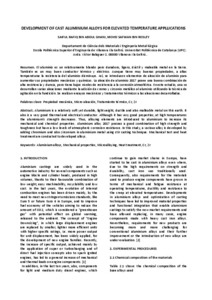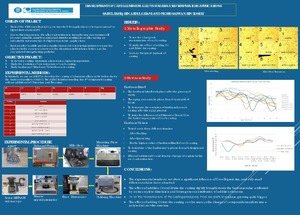Mostra el registre d'ítem simple
Development of cast aluminium alloys for elevated temperature applications
| dc.contributor | Martín Fuentes, Enrique |
| dc.contributor | Baile Puig, Maria Teresa |
| dc.contributor.author | Bin Abdul Ghani, Saiful Rafiq |
| dc.contributor.author | Bin Rosley, Mohd Safwan |
| dc.contributor.other | Universitat Politècnica de Catalunya. Departament de Ciència dels Materials i Enginyeria Metal·lúrgica |
| dc.date.accessioned | 2017-12-11T11:37:39Z |
| dc.date.available | 2017-12-11T11:37:39Z |
| dc.date.issued | 2017-07-03 |
| dc.identifier.uri | http://hdl.handle.net/2117/111672 |
| dc.description.abstract | Aluminium is a relatively soft yet durable, lightweight, ductile and also malleable metal on this earth. It also is a very good thermal and electrical conductor. Although it has very good properties, at high temperatures the aluminium’s strength decreases. At temperatures continuously above 100°C, the strength of aluminium is affected to the extent that the weakening must be taken into account. In order to compensate this relatively weakness, alloy elements are introduced to aluminium to increase its mechanical and chemical properties. Aluminium 2017 series is highly consist of copper as it principle alloying element and this alloy can be strengthened significantly through solution heat-treating. These alloys possess a good combination of high strength and toughness but have a low levels of atmospheric corrosion resistance compare to other aluminium alloy. Basically, these alloys used for aircraft and aerospace. In this study, a various alloy is developed by adding chromium and also zirconium in aluminium metal. A 9 different casting with different percentage of chromium and zirconium added is produced. The materials are prepared by stir casting technique. Mechanical test such as hardness test, microstructure test is conducted. Before the mechanical test to be conducted, these 9 castings will undergoes a series of heat treatment process such as solution heat treatment for 6 hours then rapid quenching using water as the medium and lastly aging process starting from 0 hours to 48 hours at 250°C. From the results, the hardness value and their respective microstructure is obtained. The experimental results do not show a significant influence of Cr or Zr in these parameters, and only small differences have been observed due to only small amounts of Cr and Zr have been added to an Al-Cu alloy. |
| dc.language.iso | eng |
| dc.publisher | Universitat Politècnica de Catalunya |
| dc.rights | Attribution-NonCommercial-NoDerivs 3.0 Spain |
| dc.rights.uri | http://creativecommons.org/licenses/by-nc-nd/3.0/es/ |
| dc.subject | Àrees temàtiques de la UPC::Enginyeria dels materials |
| dc.subject.lcsh | Aluminum alloys |
| dc.subject.other | Aluminium alloys |
| dc.subject.other | Mechanical properties |
| dc.subject.other | Microalloying |
| dc.subject.other | Heat treatments |
| dc.subject.other | Cr |
| dc.subject.other | Zr |
| dc.title | Development of cast aluminium alloys for elevated temperature applications |
| dc.type | Bachelor thesis |
| dc.subject.lemac | Alumini -- Aliatges |
| dc.rights.access | Open Access |
| dc.audience.educationlevel | Grau |
| dc.audience.mediator | Escola Politècnica Superior d'Enginyeria de Vilanova i la Geltrú |
| dc.audience.degree | GRAU EN ENGINYERIA MECÀNICA (Pla 2009) |




